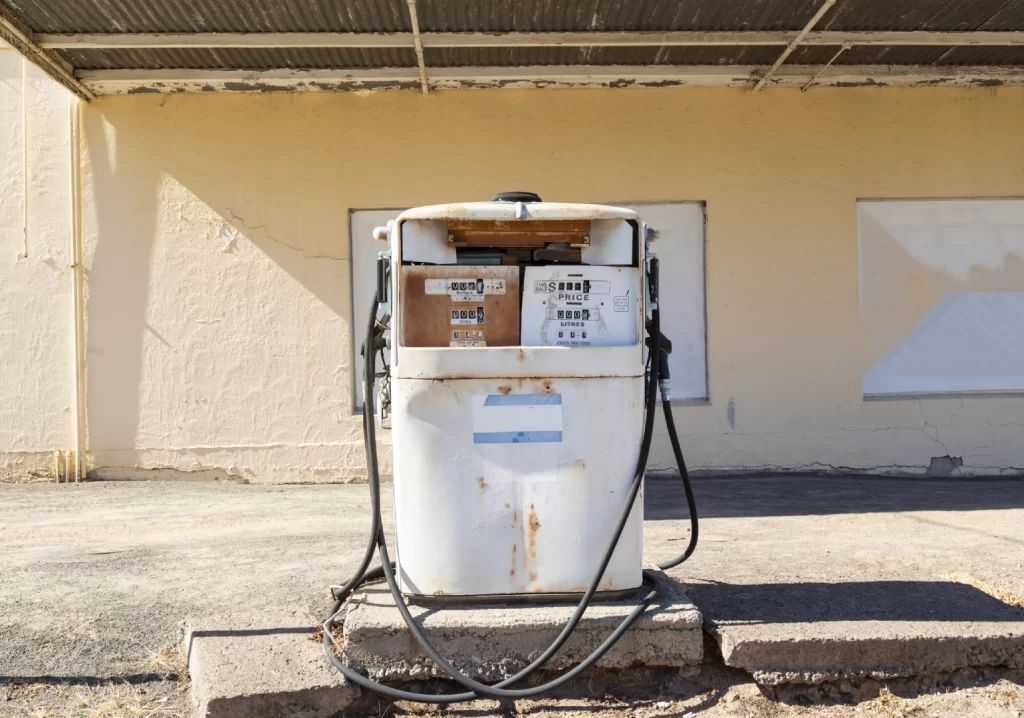As electric car sales reach an all-time high, the era of the petrol pump is drawing to a close. What will it take to prepare service stations for a second life?
Over the first half of this year, 45,000 electric vehicles (EV) were snapped up by Australian drivers, accounting for 8.4 per cent of new car sales across the nation.
And as the transition to electric transport continues over the coming decade, up to 80 per cent of service stations could lose their profit margins and close.

This is not a new phenomenon. According to figures compiled by AECOM, there were more than 25,000 petrol stations across Australia in the 1970s. Today, there are about 7000.
“This is something the industry’s been dealing with for some time,” Sally Stevenson, Associate Director in AECOM’s Geoscience and Remediation team, told create.
The greatest challenges in repurposing service stations are the cost and time required for full remediation, which can stretch to more than $1 million per site and take between two and five years.
Converting valuable sites to high or medium-density housing or commercial office buildings can be a profitable exercise for both the landowner and developer — even with the cost of remediation.
For example, in 2019, Caltex sold 25 service station sites in desirable locations across the country for a total of $136 million. Lower-value sites might leave the tanks in place and become car washes or used car yards. There is also potential to convert them to green spaces or walking paths.
Some sites still need a lot of work. According to the most recent New South Wales Environment Protection Authority (EPA) State of the Environment Report, service stations and other petrol industry installations accounted for 53 per cent of significantly contaminated sites between 2018 and 2020.
In July, the NSW EPA list of significantly contaminated sites included 892 service station sites. About 130 of these sites are no longer used for refuelling. This includes one site in the Sydney suburb of Alexandria that has since been converted into residential apartments.
The Victorian EPA’s Priority Sites Register (PSR) includes 21 service stations, with eight no longer in use. But the EPA notes that the PSR is not a full list of contaminated sites.

According to geological engineer and site contamination specialist Patrick Baldwin, there could also be a number of former service station sites that have slipped through the cracks and not been reported to the state EPAs.
“Some landowners might not know that they have service station sites which still have tanks in the ground,” Baldwin said.
“These sites aren’t being reported, managed or regulated. They are just sitting there idle.”
In the past three years, Victoria and South Australia have joined NSW and Western Australia in introducing mandatory reporting of contaminated sites.
“The legacy of derelict service stations is only going to increase once regulators become more vigilant about ensuring owners report ex-service stations,” Baldwin said.
While the prospect of hundreds of contaminated ex-servos around the nation is alarming, once the sites are identified, the risk can be managed.
Matt Tendam, Associate Environmental Engineer at Aurecon and a board member of Engineers Australia’s Environmental College, explained that engineers can turn the risks of contaminated sites into opportunities.
“Our modern lives are dependent on the use of tens of thousands of chemicals,” he said. “Sometimes those chemicals make their way into the environment. Managing the risk appropriately in line with beneficial land uses and other engineering considerations is key to creating a brighter future for generations to come.”
Contamination and remediation
According to EPA Victoria, underground petrol storage systems (UPSS) at petrol stations are a major source of both land and groundwater contamination. This can lead to environmental damage, a hefty clean-up bill and risks to people’s health.
Tendam explains that historically, petrol and diesel leaking from UPSS have caused contamination of soil, soil vapour and groundwater.
“The potential risks are dependent on the location of a service station in relation to sensitive human or ecological receptors,” he said. “For example, use of groundwater for potable or non-potable purposes, potential for inhalation of vapours, direct contact with soil or proximity to a surface water body.”
Soil vapour can also travel upwards and affect the indoor air quality of basements onsite or in neighbouring residences.
Tendam believes that most subsurface contamination is due to legacy issues from old UPSS that have since been replaced.
“Once petroleum is released to the ground, it takes many years or decades to remediate,” he said. “Often, it is not technically or economically viable to remediate the impacted soil, soil vapour or groundwater to non-detectable concentrations.”
Modern UPSS systems with leak-control devices and monitoring have greatly reduced the issue. But even small petrol leaks can lead to significant contamination.
“If you are pushing 100,000 litres into a tank and you have a very minor leak, you might lose 500 or 600 litres each time,” Baldwin said. “But if you multiply that by one load a week over a 30-year lifespan that adds up to a lot of leaked fuel.”
Some elements of fuel, including benzene, a carcinogen, can also be dissolved in groundwater and travel a significant distance from the site.
So how can these sites be cleaned up? In Australia, remediation is usually tackled on a site-specific basis, which uses a risk assessment approach to balance the available budget and time with factors such as the technology used, extent of remediation, site geology and size, and intended land use.
For example, a site slated for residential development or childcare would require a higher level of remediation than an industrial development.
To do this, engineers and other remediators need to understand the known and unknown sources of chemical contamination on a site, how chemicals travel through the environment, and the ways people and landscapes can be exposed to them.
For example, petrol leaking from a UPSS could travel through the groundwater as a liquid and come up through a bore water well to be drunk as potable water, or used in irrigation. This is usually summarised in a conceptual site model.
Regional remediation
In country towns, the cost of remediation is a barrier that is hard to overcome. For around a decade, a disused service station at the entrance to the historic town of Beaufort in western Victoria was a graffiti-covered eyesore.
Thanks to the efforts of a local community group, the site now boasts a café and coworking space. It’s also home to a museum that celebrates the life and legacy of chemist and food technologist Cyril Callister, who invented the iconic spread Vegemite.
Full remediation of a former service station site typically involves assessing the contamination, removing underground tanks and cleaning up the soil and groundwater.
“This can cost from $500,000 to over $1 million if significant work is required,” Baldwin said.
Liza Robinson is President of the Beaufort Progress Association, which now leases the revamped site, dubbed Servo@23. The 1950s building is rich in local history, but its land value does not make a full remediation effort worthwhile.
“The cost of remediation is pretty much out of the ballpark for a tiny little town like Beaufort,” Robinson said. “They couldn’t sell it for the amount of money it would take to fix it.”
This is not uncommon in regional towns, according to Baldwin.
“It’s very hard for the regulators to force clean-up, because clean-up is expensive,” he said. “Quite often those legacy site owners don’t have the funds to manage the clean-up or even the contamination.”
Technology selection
Remediation technologies can be divided into in-situ solutions, which treat the contamination sources in place without excavation, and ex-situ solutions, which require excavation of contaminated materials.
“Globally, the industry has generally moved away from large-scale mechanical and electrical systems for remediation to ‘in-situ’ technologies,” Tendam said.
Tendam said one of the more interesting in-situ strategies he has used is injection of a sulphate source — such as gypsum — to stimulate the natural biodegradation process, and monitor its process.
Called monitored natural attenuation, this involves bacteria eating the spilt fuel. Although it takes many years to complete, it is one of the most cost-effective remediation techniques.
Baldwin has also used in-situ technologies in several of his petrol station remediation projects. One of these technologies is in-situ chemical oxidation (ISCO). This involves injecting chemicals into the ground to destroy the petrol or diesel hydrocarbons.
“The chemicals are designed to break down into non-toxic, environmentally friendly by-products once they have done their job,” Baldwin said.
Another, more aggressive, technology used in petrol station remediation is multiphase vacuum extraction, or MPE. This involves installing extraction wells where spilled petroleum hydrocarbons have leaked into groundwater.
Remediators use a high-powered vacuum to remove the hydrocarbon as both a liquid and as vaporised droplets, which speeds up the extraction process.
“Speed is money, so a lot of people remediating these sites want to do it as quickly as possible,” Baldwin said, adding that even aggressive remediation technologies take months to work.
It’s important to select the right technology for the site geology and type of spill.
If the spill is large and complex and has spread quite a long way, Baldwin explained, he might use one of the more aggressive technologies.
On legacy sites, the contamination plume in groundwater is usually quite old, and may have soaked into the soil. This means that aggressive technologies won’t work, and a natural attenuation solution will be a better fit.
“It’s a balancing act between the type of attenuation, the size of the contamination plume, and how much time you have,” Baldwin said.
Soil vapour on redeveloped sites — which can contain compounds such as benzene — can also be controlled with membranes and soil vapour extraction systems.
Monitoring the problem
Over the past three decades, petroleum companies have prioritised remediation of their higher-risk sites, but ongoing monitoring is needed to detect and prevent future issues.
“Engineers can help by designing and facilitating a routine monitoring program to detect leaks early and monitor any known impacted sites,” Tendam said.
When leaks are detected, environmental engineers evaluate, recommend and design appropriate remediation technologies and strategies to reduce the amount of petrol contamination and reduce the risk.
Other engineering disciplines are also involved in petrol station clean-ups.
For example, civil engineers might oversee the installation of new UPSS, along with leak prevention and detection equipment; geological and geotechnical engineers specialise in underground rock formations; and process engineers might be involved in the design of remediation systems.
Modern UPSS at operating service stations are made from corrosion-resistant fibreglass and have double walls to prevent leaks.
This can be combined with leak monitoring using devices to draw samples from monitoring wells, and electronic inventory monitoring to track fuel entering and leaving the system.
Decommissioned and redeveloped sites may also be monitored to track soil vapour and soil or groundwater contamination.
“All of these measures have greatly reduced the potential for leaks or that leaks will be detected as early as possible to address them as soon as practicable,” Tendam said.
